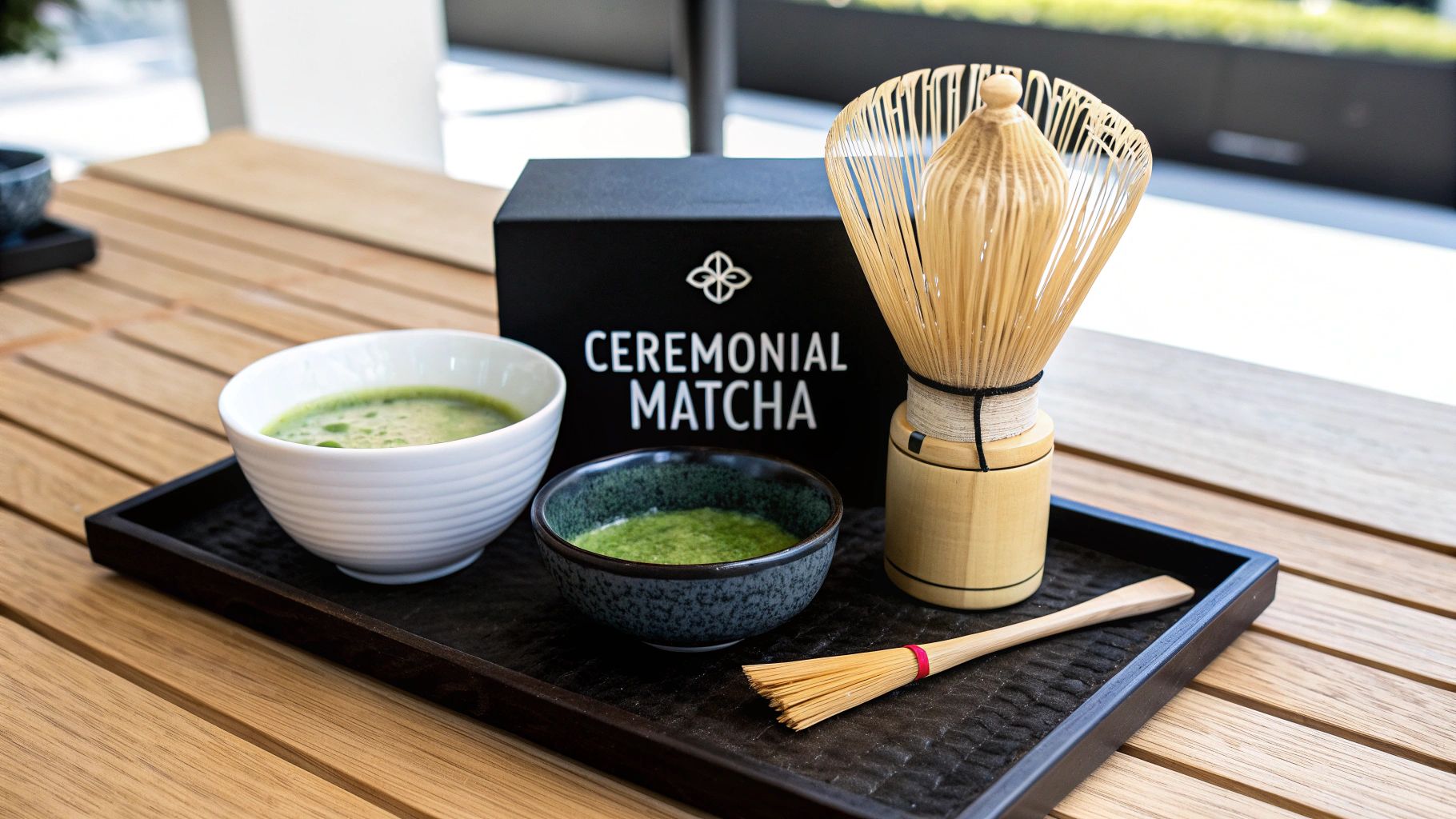A ceremonial matcha tea set is so much more than a few fancy utensils. Think of it as a dedicated system, perfectly designed to coax the very best out of high-quality matcha powder and transform it into a smooth, frothy, vibrant green tea.
Simply stirring matcha powder into hot water with a spoon just doesn’t cut it. To unlock the full, nuanced flavour and tap into the health benefits of authentic ceremonial matcha powder, you need the right tools for the job. A traditional set comes with four core components that work together beautifully, honouring a ritual that’s centuries old.
Your Gateway to the Art of Matcha
Starting your matcha journey is about more than just making a drink; it's an invitation to a practice of mindfulness. And having the right tools makes all the difference. A ceremonial matcha set isn't just for show – each piece has a specific, vital function that a kitchen spoon or a regular coffee mug simply can't perform. Using the proper set helps you avoid lumps, create that signature creamy foam, and truly taste the complex, umami-rich flavour profile the way it was meant to be enjoyed.
It's clear this mindful approach is catching on. The UK matcha tea market, currently valued at around $137.25 million USD, is expected to boom to nearly $517.96 million USD by 2035. This incredible growth shows a real shift towards appreciating authentic tea experiences. You can discover more insights about the UK matcha market on marketresearchfuture.com. This growing interest is exactly why understanding the tools is the perfect first step to building a rewarding daily ritual.
The Four Essential Pieces
At its heart, a traditional matcha set is built around four key tools. Each one has a Japanese name and a unique role to play, coming together to make the preparation process seamless and enjoyable.
-
Chawan (Bowl): This is where the magic happens. A proper matcha bowl has a wide, flat bottom, which gives you the perfect surface for effective whisking. It lets you build a rich froth without splashing tea everywhere.
-
Chasen (Bamboo Whisk): The real star of the show. This handcrafted whisk is made from a single piece of bamboo, split into dozens of delicate tines. Its job is to aerate the tea and dissolve the powder completely, creating that iconic creamy texture that makes matcha so special.
-
Chashaku (Bamboo Scoop): This elegant, slender scoop is designed to measure out the perfect amount of matcha powder for one serving—usually about 1-2 grams. It helps you get a consistent taste in every single bowl.
-
Kusenaoshi (Whisk Holder): This piece is often overlooked, but it's absolutely crucial for keeping your whisk in good shape. The ceramic holder helps the delicate bamboo tines of the chasen dry properly and maintain their elegant curve, which will dramatically extend its life.
When you use these purpose-built tools, you’re doing more than just making a drink. You’re taking part in a meditative practice that helps calm the mind and awaken the senses. It turns a simple daily act into a moment of pure focus and tranquillity.
Before we go deeper, here’s a quick overview of the essential tools and what they do.
Key Tools in a Ceremonial Matcha Set
| Tool Name | Japanese Name | Primary Function |
|---|---|---|
| Matcha Bowl | Chawan (茶碗) | Provides a wide, flat surface ideal for whisking and frothing. |
| Bamboo Whisk | Chasen (茶筅) | Aerates the tea and dissolves powder to create a creamy texture. |
| Bamboo Scoop | Chashaku (茶杓) | Measures the perfect amount of matcha powder for a single serving. |
| Whisk Holder | Kusenaoshi (くせ直し) | Maintains the whisk's shape and helps it dry properly to prolong its life. |
Having these four items forms the foundation of a truly authentic matcha experience.
Ultimately, investing in a proper set is the first real step towards appreciating this beautiful art form. It ensures that the premium powder you've chosen is prepared correctly, allowing its full potential to shine through.
Understanding Each Tool in Your Matcha Set
A ceremonial matcha tea set is a beautiful thing. It's a perfect example of form meeting function, where every single piece is designed to work in harmony. Think of it less like a random collection of kitchen gear and more like a specialist's toolkit. Each tool has a very specific job, refined over centuries, to turn fine matcha powder into that perfectly smooth, frothy drink we love.
When you start to appreciate the ‘why’ behind each item, your connection to the ritual deepens. Suddenly, you understand why the bowl has that particular shape or why the whisk has so many delicate prongs. The process becomes more than just making a drink—it turns into a moment of mindfulness. Let's get to know the four essential pieces and the clever design that makes them work so well.
The Chawan: The Canvas for Your Matcha
The Chawan (茶碗), or matcha bowl, is where it all begins. At first glance, you might think it's just a regular bowl, but its design is incredibly deliberate. The wide, flat bottom creates the perfect surface area for whisking, giving the tines of the whisk (chasen) all the room they need to move and whip air into the tea.
This generous space is what helps you build that signature creamy foam that makes a good bowl of matcha. If you try to use a standard coffee mug, with its narrow base and tall sides, you just can't get that vigorous 'W' or 'M' whisking motion going. The Chawan’s design not only helps you create froth but also prevents splashing, ensuring every last particle of that precious matcha is perfectly blended.
A well-crafted Chawan isn't just a vessel; it's the stage where your matcha ritual plays out. Its shape is engineered to help you achieve the perfect froth, making it an irreplaceable part of any true ceremonial matcha tea set.
The Chasen: The Artist’s Brush
If the Chawan is the canvas, then the Chasen (茶筅) is the artist’s brush. This intricate bamboo whisk is probably the most iconic tool in the set, and for very good reason. It’s handcrafted from a single piece of bamboo, with its delicate tines carefully split and curled to create an incredibly effective aerating tool.
The main job of the chasen is to suspend the fine matcha powder in the water while whipping air into the mixture. This creates a rich, creamy microfoam (known as 'kama') and gets rid of any lumps, leaving you with a silky-smooth texture. Using a regular metal whisk would be far too harsh; it could scratch the bowl and wouldn't be able to produce the right kind of delicate foam.
The number of prongs on a chasen can vary, usually from 80 to 120.
- 80-Prong Chasen: A great choice for beginners. It's sturdy and whips up a lovely, thick foam with ease.
- 100-Prong Chasen: This is a popular all-rounder for daily use. It offers a fantastic balance between durability and the ability to create a fine, creamy froth.
- 120-Prong Chasen: Favoured by seasoned enthusiasts, this whisk has finer tines that produce an exceptionally delicate and smooth foam, which is ideal for the thicker style of matcha called koicha.
The Chashaku: The Measuring Spoon
When making matcha, precision is everything. The Chashaku (茶杓) is the tool that makes it happen. This elegant bamboo scoop is designed to measure out the perfect amount of matcha powder for one serving, which is usually between one and two grams.
Unlike a clunky teaspoon, the Chashaku's slender, curved shape lets you gracefully scoop the fine powder from its container without making a mess. Using one or two level scoops ensures you get a consistent flavour and strength every time. This attention to measurement is a key part of the discipline and mindfulness at the heart of the Japanese tea ceremony. If you'd like to dive deeper into the ceremony itself, you can explore the rich history and steps of the traditional Japanese tea ceremony in our detailed guide.
The Kusenaoshi: The Whisk Preserver
Last but not least is the often-overlooked Kusenaoshi (くせ直し), or whisk holder. This simple ceramic piece is absolutely essential for maintaining the shape and extending the life of your Chasen. After each use, the delicate bamboo tines of the whisk are wet and soft.
By placing the rinsed Chasen on the Kusenaoshi, it can air dry evenly while the holder coaxes the tines back into their correct, open shape. If you just leave it on its side, the tines will dry clumped together, lose their curl, and eventually become brittle and break. The Kusenaoshi protects your investment, ensuring your ceremonial matcha tea set stays in perfect working order for years of mindful brewing.
How to Choose the Right Matcha Tea Set
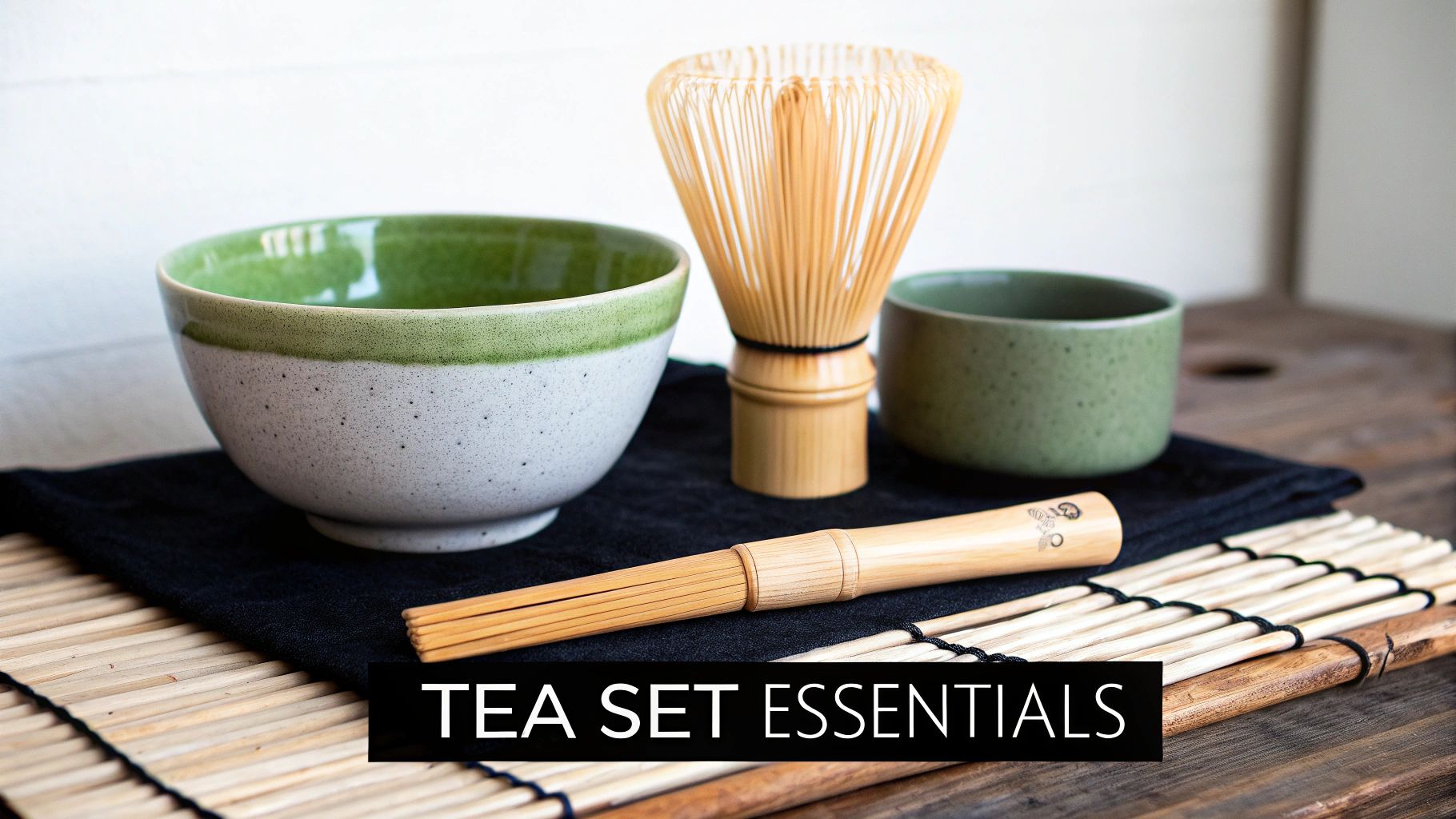
Choosing your first ceremonial matcha tea set is an exciting part of the journey. This isn't just about buying a few tools; it's about finding the right companions for a mindful daily ritual. A well-chosen set truly deepens your connection to the process and, believe me, it makes a world of difference to the flavour of your matcha.
Think of it like an artist selecting their paintbrushes. Sure, any old brush can get paint on a canvas, but the right one makes the experience feel effortless and the final piece so much more beautiful. It’s the same with matcha. Investing in a quality set transforms a simple task into a deeply satisfying experience.
This guide will walk you through the essential things to look for, helping you tell the difference between genuine craftsmanship and mass-produced imitations. We'll explore the materials, design, and purpose of each piece so you can find a set that feels just right for you.
Evaluating the Chawan (Bowl)
The Chawan is the very heart of your set. When you're looking at different bowls, you need to consider both how it looks and how it works. A great place to start is the material. Different ceramics offer unique textures and hold heat in different ways. Traditional Japanese styles like Mino-yaki or Hagi-yaki are treasured for their beautiful artistry and the way they feel in your hands.
Functionally, you'll want a bowl with a wide, fairly flat bottom and sides that are more or less straight. This shape is absolutely crucial because it gives the Chasen (whisk) plenty of room to move, helping you build that signature rich froth without splashing everywhere. It should also feel comfortable, big enough to whisk with energy but small enough to cradle in both hands, as is the tradition.
The right Chawan does more than just hold tea; it’s an ergonomic tool designed for the art of whisking. Its shape directly impacts your ability to create a smooth, frothy matcha, making it the most important functional choice in your ceremonial matcha tea set.
Assessing the Chasen (Whisk) and Chashaku (Scoop)
If the Chawan is the heart, the Chasen is the engine of your matcha preparation. A proper whisk is hand-carved from a single piece of bamboo. Look for one with fine, flexible tines—80-120 prongs is the sweet spot—that are evenly spaced and curled at the tips. This delicate construction is the secret to aerating the tea into a wonderfully creamy foam.
Likewise, the Chashaku is so much more than a simple spoon. Its elegant, curved design is perfectly shaped to pick up the ideal amount of fine matcha powder. A well-made bamboo scoop will feel smooth and light, helping you measure your matcha with a bit of grace and precision. It’s best to avoid plastic or metal scoops, as they just don't have the same traditional feel or aesthetic.
This appreciation for authentic tools is something we're seeing more and more. In fact, there's been a major shift in the UK over the last decade towards authentic sets from Japan. Since 2015, UK imports of traditional tea ceremony tools have shot up by an estimated 150%, especially from famous regions like Kyoto and Kyushu.
Putting It All Together For Your Needs
To help you decide what's most important, we've put together a simple comparison table. Whether you're just starting out or looking to deepen your practice, this should point you in the right direction.
Matcha Set Feature Comparison
| Feature | Beginner Priority | Enthusiast Priority | What to Look For |
|---|---|---|---|
| Chawan (Bowl) Shape | High | High | Wide, flat bottom with straight sides for easy whisking. |
| Chasen (Whisk) Prongs | Medium | High | 80 prongs is great for starting. Enthusiasts might prefer 100-120 for a finer foam. |
| Tool Material | High | High | Always choose natural bamboo for the Chasen and Chashaku. Ceramic for the Chawan. |
| Aesthetics/Artistry | Low | Medium | Focus on function first. Connoisseurs may seek out unique glazes or artisanal styles. |
| Whisk Holder (Kusenaoshi) | High | High | Essential for everyone to maintain the whisk's shape and longevity. |
Ultimately, choosing a set comes down to where you are on your personal matcha journey. Are you a beginner searching for a durable, functional starter kit, or an enthusiast ready for an artisanal set to elevate your daily ritual?
-
For Beginners: Your main priorities should be function and durability. A sturdy, 80-prong Chasen and a wide, easy-to-use Chawan are perfect starting points. A complete set that includes a Kusenaoshi (whisk holder) is a very smart buy to protect your whisk from day one.
-
For Enthusiasts: This is where you can start to appreciate true craftsmanship and unique materials. You might prefer a 100- or 120-prong Chasen for an even finer foam, or a handmade Chawan with a distinctive, one-of-a-kind glaze. The subtle differences in these tools add a whole new layer to your ritual. The matcha itself is key; a premium blend like Amatsu's Pure or Radiance will allow you to taste the full spectrum of flavour.
No matter your level, investing in a thoughtfully curated set from a trusted source like Amatsu Matcha ensures every component is designed to work together in harmony, helping you create that perfect bowl, every single time.
Preparing Matcha with Your Ceremonial Set
With your beautiful ceremonial matcha tea set in hand, it's time to bring the ritual to life. This is the moment where the tools, the powder, and your intention all come together to create a perfect bowl of matcha. Preparing matcha is a mindful practice, and every single step is there for a reason, helping to guarantee a smooth, flavourful, and frothy result.
The process itself is quite simple, but each action has a purpose, from warming the bowl to that final whisking motion. Following these steps will help you sidestep common pitfalls like clumpy powder or a bitter taste. Instead, you'll be rewarded with a vibrant, delicious, and energising bowl of tea, even on your very first try.
Remember, for the most authentic experience, the quality of your matcha is just as crucial as your technique. A high-quality ceremonial grade powder, like Amatsu Matcha's Radiance blend, is crafted from the youngest tea leaves. This gives it a naturally sweet, umami-rich flavour and a brilliant green colour that’s perfect for this traditional preparation.
Step 1: Prepare Your Tools and Matcha
The first step in any ritual is always preparation. Start by pouring a little hot water into your Chawan (bowl) just to warm it up. Let it sit for a minute, then tip out the water and dry the bowl completely with a soft cloth. This simple action helps your matcha stay at the ideal temperature for longer.
Next comes a crucial step: sifting your matcha. Matcha is incredibly fine and loves to clump together because of static electricity. Pushing it through a small, fine-mesh sieve directly into the Chawan breaks up any lumps—this is the secret to an impeccably smooth drink.
Using your Chashaku (bamboo scoop), measure 1-2 scoops (which is about 2 grams or one teaspoon) of matcha into the sieve. Gently tap the side of the sieve to work the powder through into your pre-warmed bowl.
Step 2: Add Water at the Right Temperature
The temperature of your water can make or break the flavour of your matcha. If it's too hot (boiling), it will scorch the delicate tea leaves, resulting in a bitter, astringent taste nobody wants. The sweet spot is around 80°C (175°F).
Don't have a temperature-controlled kettle? No problem. Simply boil the water and let it cool for a few minutes before pouring. Add about 60-80ml (2-3 ounces) of the hot water to the bowl with the sifted matcha. Now you're ready for the most important part: whisking.
This simple infographic below shows the core process for getting that perfect bowl every time.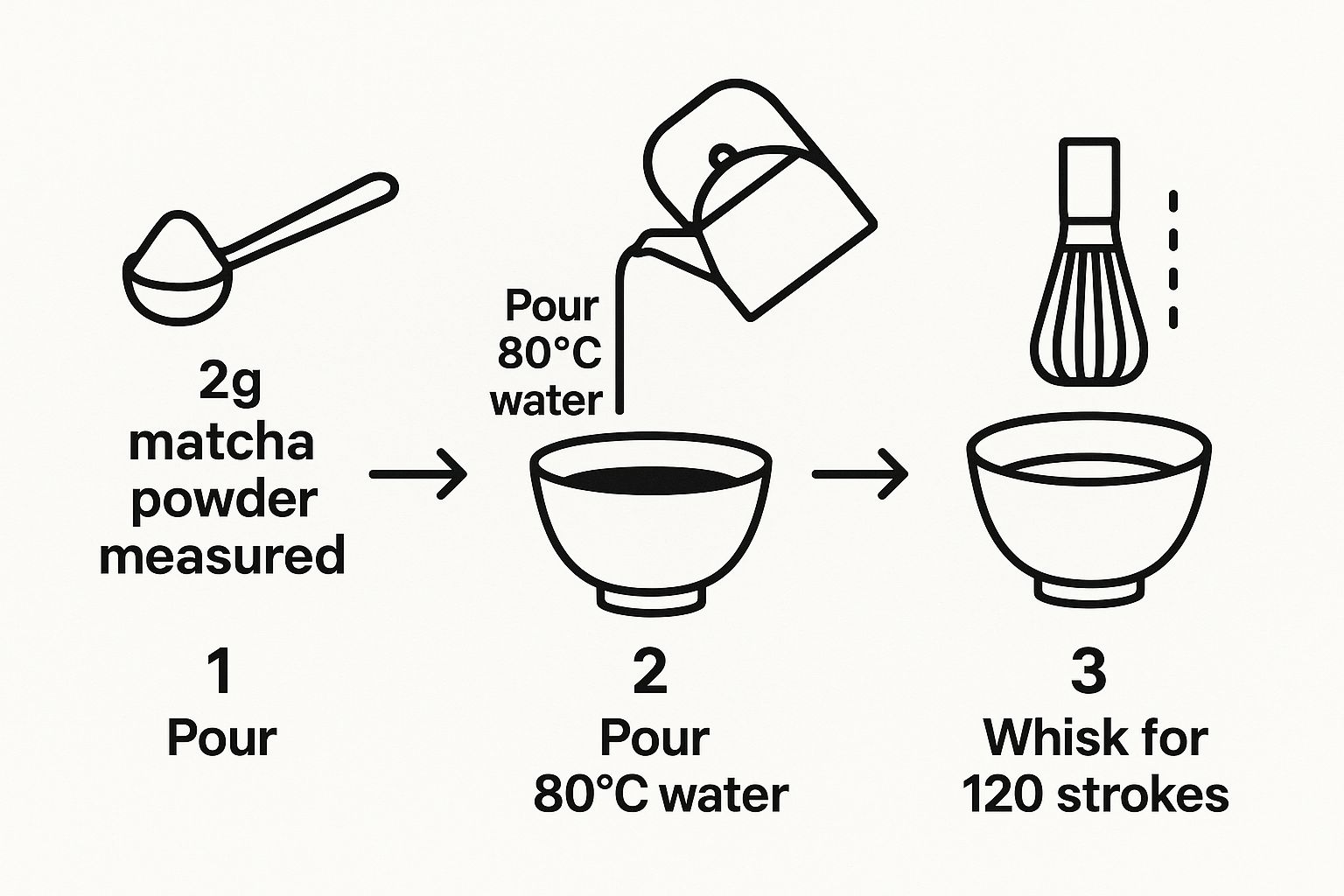
Following these key measurements for powder, water temperature, and whisking is the foundation for creating a traditional bowl of usucha (thin tea).
Step 3: The Art of Whisking
Whisking is where the magic really happens. But first, soak the tines of your Chasen (bamboo whisk) in warm water for a minute. This makes them soft and pliable, which prevents breakage and helps create a much better foam.
Hold the Chawan firmly with one hand and the Chasen with the other. The trick is to whisk with your wrist, not your whole arm, in a rapid 'M' or 'W' shaped motion. The goal is to agitate the mixture quickly, moving back and forth across the entire width of the bowl.
Don't press the whisk against the bottom of the bowl. Instead, let the tips of the tines dance just above the base to incorporate air. This technique is what builds that signature creamy, frothy layer on top.
Keep whisking for about 20-30 seconds, or until the matcha is completely dissolved and a thick layer of delicate foam covers the surface. You shouldn't see any large bubbles. For a deeper dive into techniques and troubleshooting, feel free to explore our comprehensive guide on how to prepare matcha perfectly.
Once you've achieved that beautiful froth, gently lift the whisk from the centre of the bowl. Your perfect bowl of ceremonial matcha is now ready. Take a moment to appreciate the aroma and vibrant colour before you take your first sip.
How to Care for Your Matcha Tools
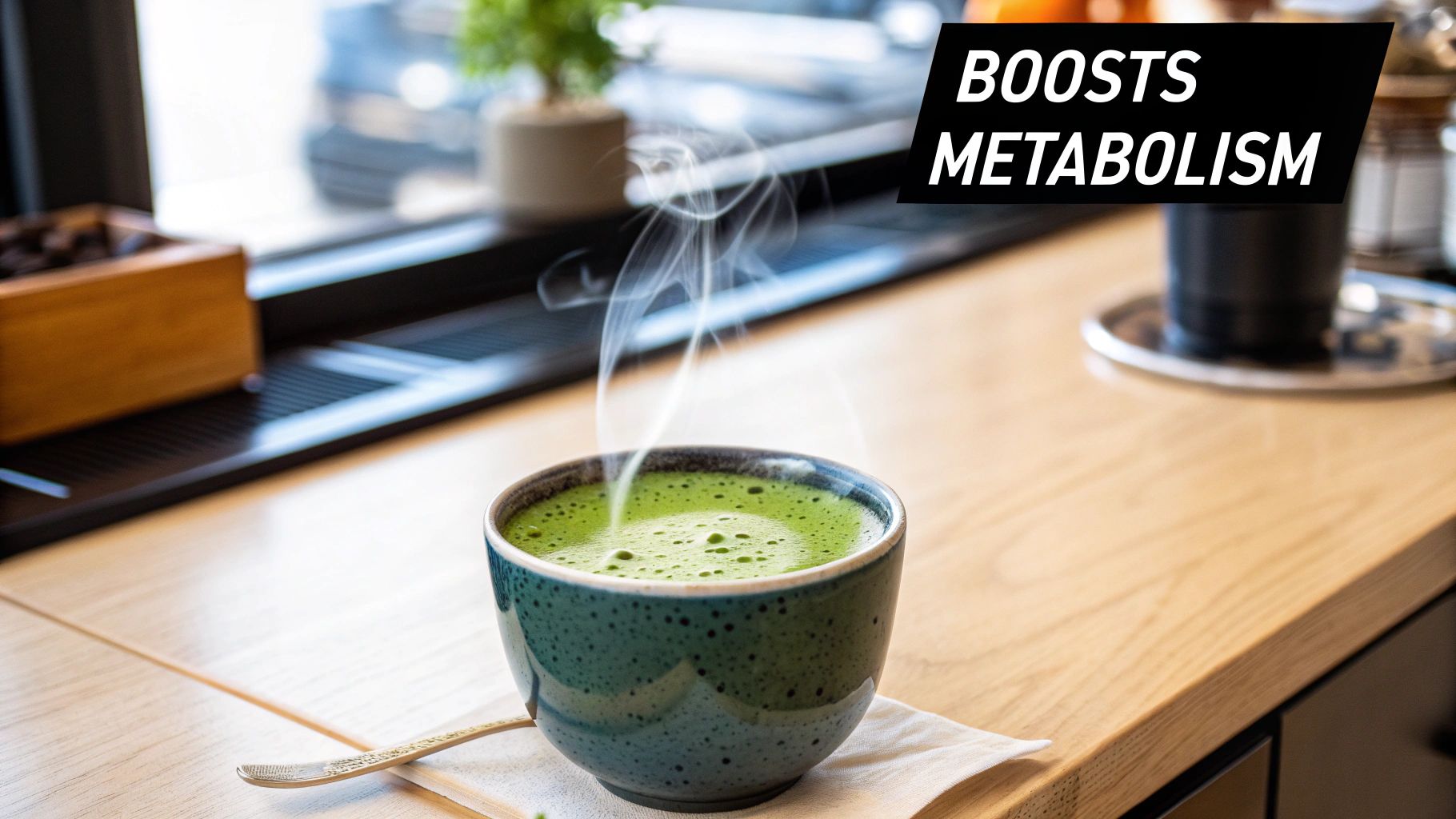
Think of your ceremonial matcha set as an investment in a daily ritual that nourishes you. With just a little attention after each use, these beautiful tools can serve you faithfully for years. Proper care isn't just about cleaning; it’s about honouring the tradition and ensuring every bowl of matcha you prepare is as pure and delicious as the last.
Each piece of the set needs a slightly different touch. The golden rule is to be gentle. Avoid harsh soaps or abrasive scrubbers that could damage the natural materials or, even worse, taint the delicate flavour of your tea. See it not as a chore, but as the final, mindful step in your matcha practice.
Caring for Your Chasen and Chashaku
Your bamboo tools are the most delicate members of the set. The Chasen (whisk), with its fine tines, requires the most careful handling to maintain its shape and function.
After you've finished whisking, a simple rinse under a gentle stream of warm water is all it needs. Never use soap, as it can cling to the bamboo and ruin the taste of your next brew. Just swish the whisk in the water to dislodge any matcha, give it a gentle shake to remove excess water, and you're done.
The most critical step for your whisk is how you dry it. Immediately place the damp Chasen on its Kusenaoshi (whisk holder). This isn't just for show – it allows air to circulate and, crucially, helps the tines curl back into their original open shape. This simple habit will dramatically extend the life of your whisk.
The Chashaku (scoop) is far easier to look after. Since it typically only touches dry matcha powder, a quick wipe with a soft, dry cloth is usually all it needs. If it does get wet, be sure to dry it right away to prevent the bamboo from warping over time. If you want to dive deeper into this essential tool, you can check out our complete guide on the matcha green tea bamboo whisk.
Maintaining Your Chawan
Looking after your Chawan (bowl) is straightforward, but it’s all about a gentle touch. The goal is to get it clean without damaging the unique glaze or leaving any soapy residue that could interfere with your matcha's complex flavour profile.
Just follow these simple steps after each use:
- Rinse Right Away: As soon as you’ve enjoyed your matcha, give the bowl a quick rinse with warm water. This stops any tea particles from drying and sticking to the surface.
- Use a Soft Cloth: If a simple rinse isn't enough, gently wipe the inside with a soft cloth or sponge. Steer clear of abrasive pads that could scratch the beautiful glaze.
- No Harsh Soaps: Like the whisk, it's best to avoid dish soap. Some ceramics are slightly porous and can absorb scents and flavours, which is the last thing you want in your next bowl.
- Air Dry Completely: After rinsing, let the Chawan air dry on a rack or carefully pat it dry with a dedicated tea towel before putting it away.
By treating your tools with this little bit of care, your ceremonial matcha set will remain a beautiful and functional centrepiece of your daily ritual for a long, long time.
Making Matcha More Than Just a Morning Habit
So, you've got the basics down. You can whip up a decent bowl of matcha without much fuss. But what if that simple morning routine could be something more? This is where your ceremonial matcha set truly shines, helping you turn the act of making a drink into a quiet moment of presence and self-care. It’s a subtle shift in mindset, but it makes all the difference.
There’s a beautiful Japanese concept that gets to the heart of this: ‘Ichigo Ichie’ (一期一会). Roughly, it means "one time, one meeting." It's a reminder that every single moment is unique and will never come around again. When you bring this idea to your matcha bowl, each step—from scooping the powder to the final whisk—becomes a singular experience worth appreciating.
From a Quick Brew to a Mindful Moment
Turning your matcha prep into a form of meditation isn't about adding more time to your day; it’s about changing where you put your focus. Instead of rushing, slow down. Pay attention to the little things.
Feel the warmth of the chawan cupped in your hands. Watch the brilliant green of the powder as it falls through the sifter. Listen to the soft whisk of the chasen as it dances through the water, coaxing the tea into a perfect froth. This simple, focused attention is incredibly grounding. It can calm your nerves and clear your head before the day’s chaos kicks in, transforming a routine into a ritual you genuinely look forward to.
‘Ichigo Ichie’ invites you to treat every bowl of matcha as a once-in-a-lifetime event. Suddenly, making tea isn’t a chore; it’s a powerful way to practise mindfulness and appreciate the here and now.
Ready to Go Deeper? Try Koicha (Thick Tea)
Once you're comfortable with your daily matcha, you might feel the pull to explore Koicha (濃茶), or thick tea. The usucha (thin tea) we make every day is light and refreshing. Koicha, on the other hand, is something else entirely—a richer, more intense style usually saved for special ceremonies or deep meditation.
You’ll use double the matcha (about 4 grams) with about half the water, creating a texture almost like warm honey. The flavour is powerful—deeply umami and complex, with absolutely no bitterness. You don't whisk it frantically; instead, you use a slow, deliberate, kneading motion to gently combine the powder and water. For this, you'll need a truly high-grade ceremonial matcha like Amatsu's Pure or Radiance, as anything less will taste unpleasantly astringent.
Matching Your Matcha to Your Mindset
Another way to elevate your practice is to get intentional with it. Your matcha can be more than just a caffeine hit; it can be functional fuel for what you want to achieve.
Think about what your day holds and choose a blend to match:
- Need to focus? Before a big project or a packed day of meetings, a bowl made with a blend like Amatsu Matcha's Shrooms can really help sharpen your mind.
- Hitting the gym? If you're getting ready for a workout, a blend like Amatsu Matcha's Strength can help prime your body for activity and support your recovery afterwards.
When you start pairing your inner state with the physical act of making tea, your ceremonial matcha set becomes more than just beautiful tools. It becomes a key part of your personal wellness toolkit.
Common Questions About Ceremonial Matcha Sets
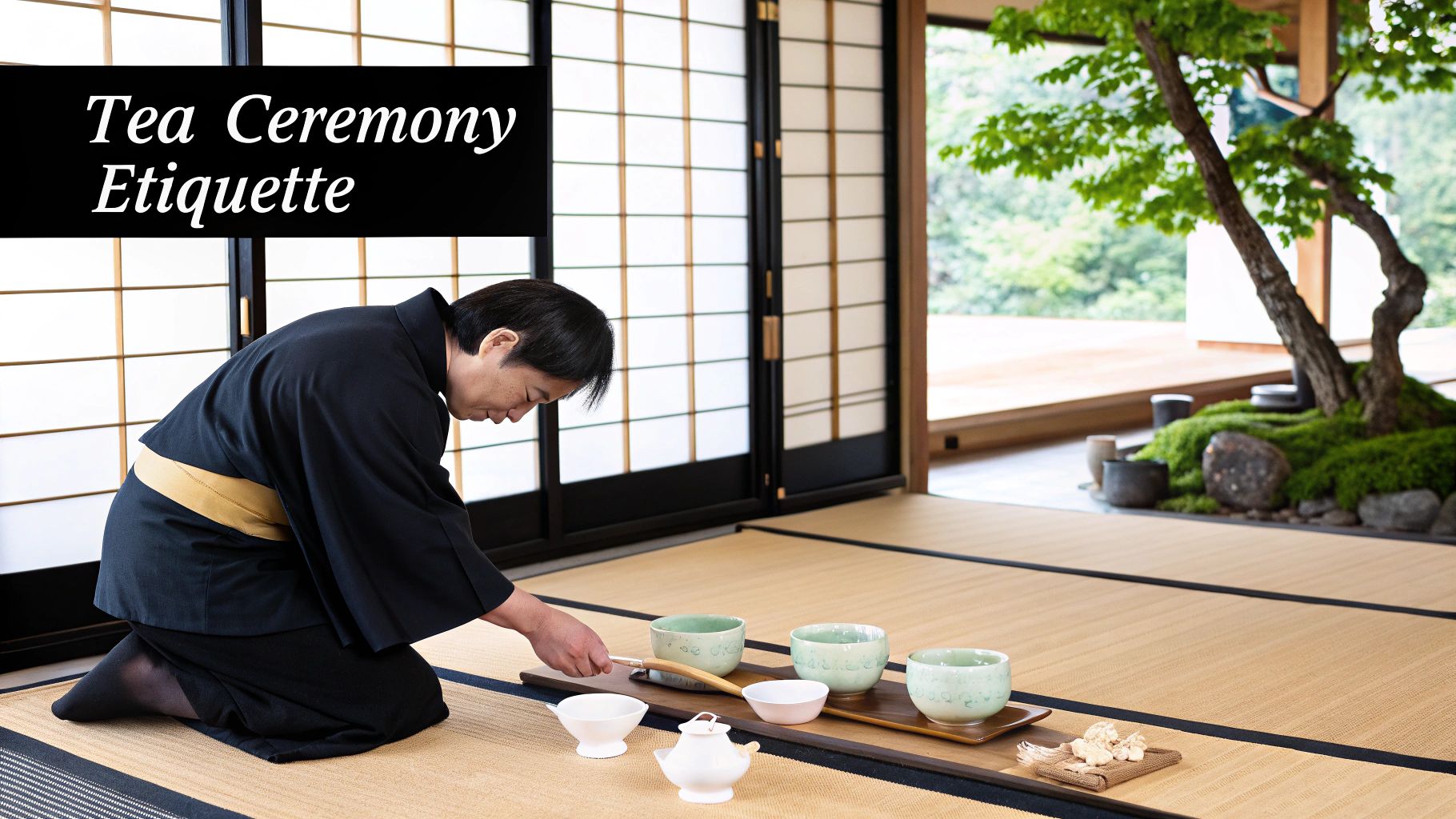
Starting a new practice always brings up a few questions. To help you feel completely at ease with your new ceremonial matcha tea set, here are some straightforward answers to the queries we hear most often.
Can I Just Use Any Old Bowl for Matcha?
While you can use another bowl if you're in a pinch, you'll quickly see why a proper chawan is worth it. Its wide, flat bottom isn't just for looks; it's designed to give your whisk enough space to move freely and whip up a beautiful foam without splashing matcha all over your counter.
This unique shape lets the whisk’s tines connect perfectly with the powder and water, which is the secret to getting that smooth, frothy texture you simply can't achieve in a regular mug.
How Do I Stop My Bamboo Whisk from Breaking?
This is a great question, as those bamboo tines are delicate. The trick is all in the preparation. Always soak your chasen in warm water for about a minute before you start whisking. This simple step makes the bamboo flexible and much less likely to snap.
After you're done, rinse it gently under warm water—and please, never use soap or put it in the dishwasher! The final, most important step is to let it air dry on its kusenaoshi (whisk holder).
The kusenaoshi is much more than a simple stand. It’s an essential tool that helps the fragile tines maintain their elegant curve and structural strength, ensuring your whisk will be ready for hundreds more bowls of matcha.
Do I Really Need to Use Ceremonial Grade Matcha?
Honestly, for the true experience, ceremonial grade matcha is the only way to go. You could use other grades, but the difference is night and day.
This top-tier powder comes from the youngest tea leaves and is ground to an incredibly fine consistency. It’s specifically made to be whisked with hot water and savoured on its own, delivering a smooth, complex flavour completely free of bitterness. If you try to prepare a lower, culinary grade matcha this way, you’ll likely end up with a gritty, unpleasantly bitter brew. For a flawless experience, start with a high-quality blend like Amatsu's Pure.
Your journey into the mindful practice of matcha begins with having the right tools and the perfect powder. At Amatsu Matcha, we source authentic, high-quality ceremonial matcha and curated sets to help you create a truly meaningful daily ritual.
Explore our full range of premium matcha blends at Amatsu Matcha
Read more
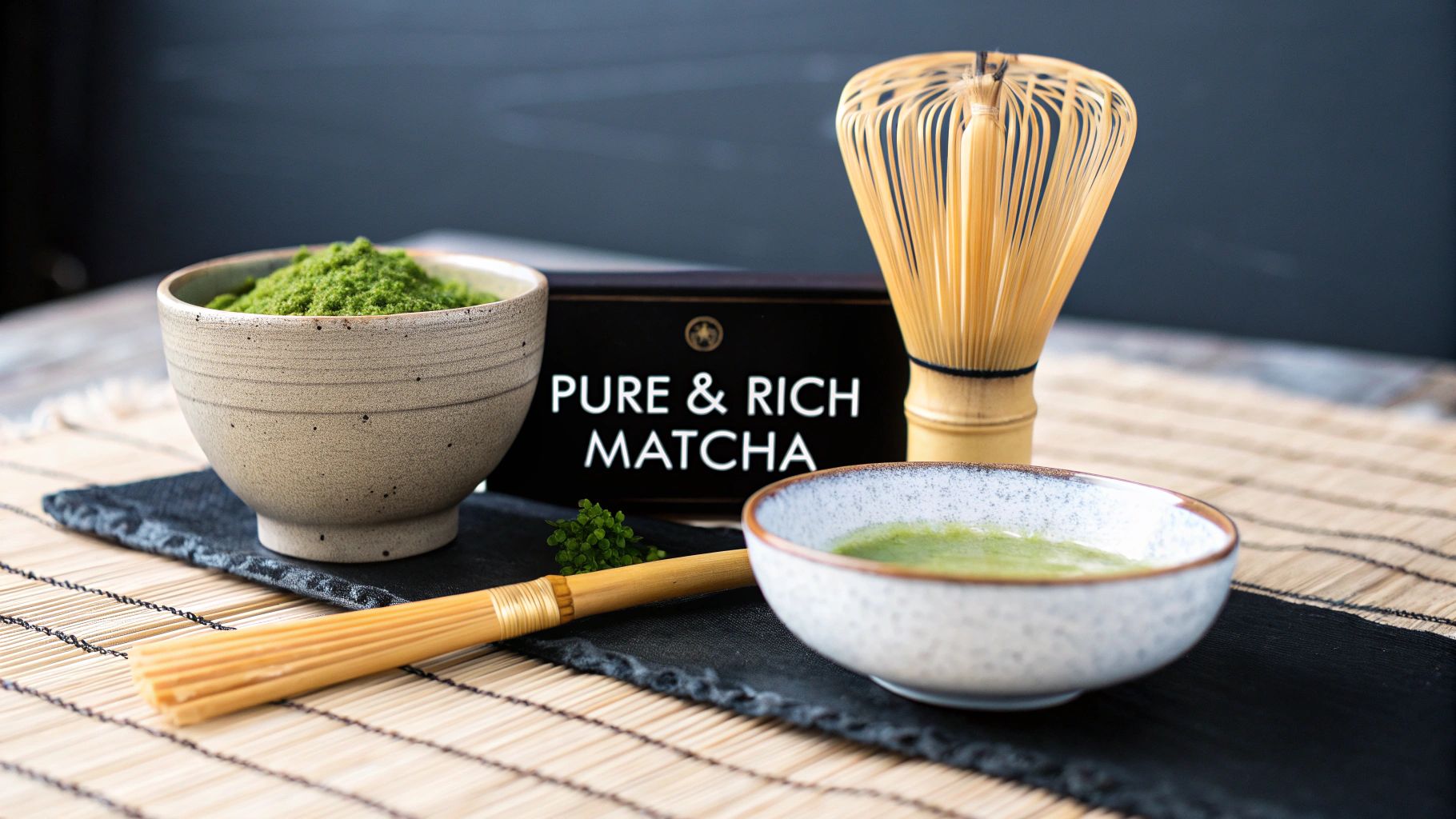
Explore ceremonial organic matcha's health benefits, history, and brewing tips. Elevate your daily ritual with the purest ceremonial matcha today!
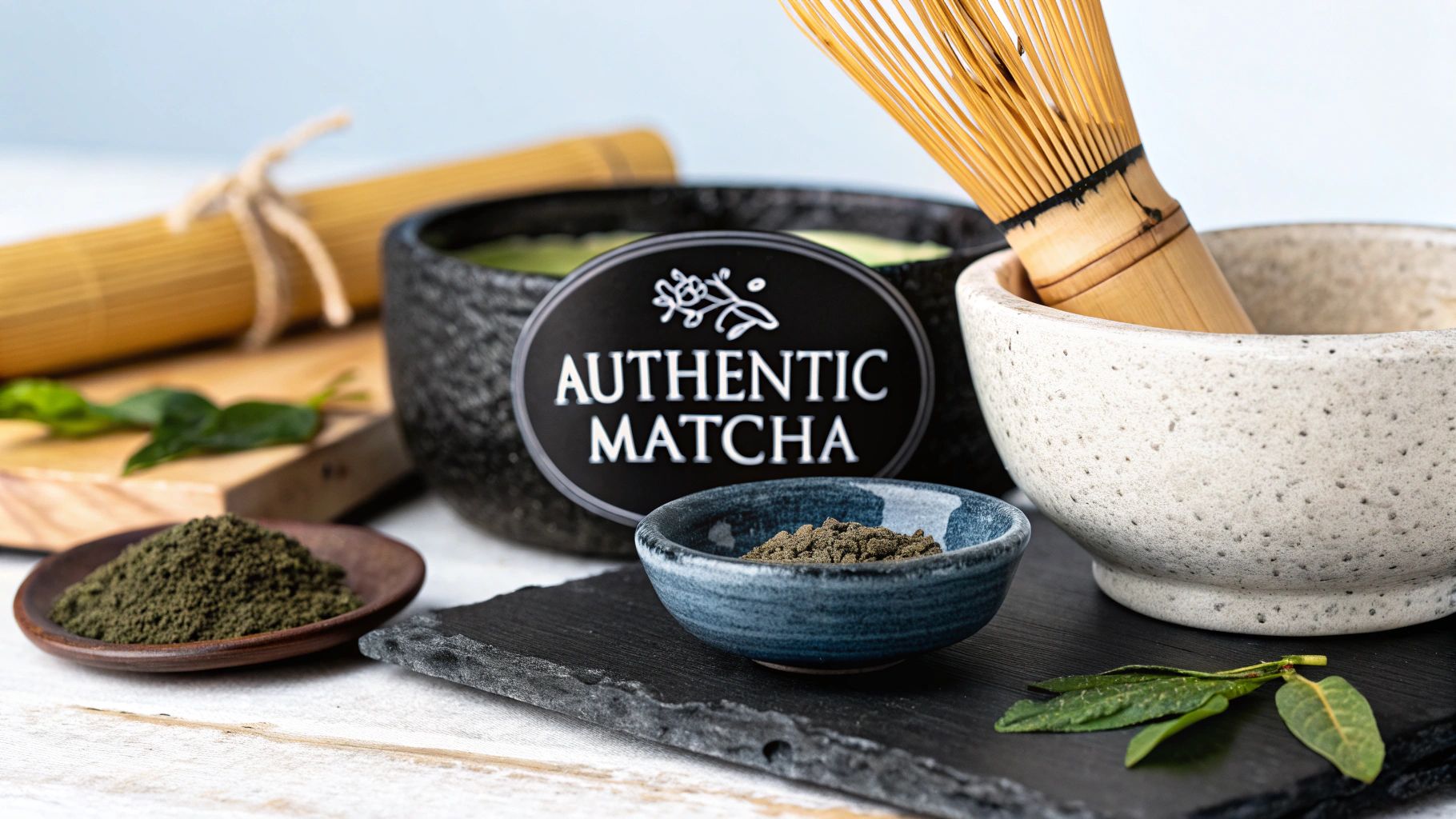
Discover authentic matcha powder from Japan. Our guide explores quality grades, health benefits, and how to brew the perfect cup for a genuine experience.
